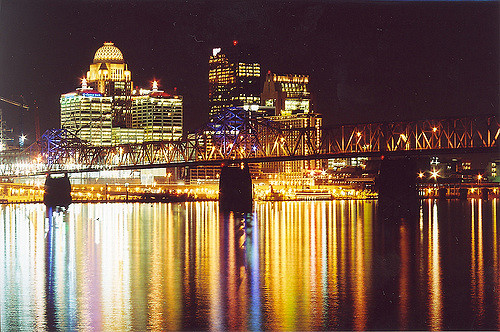Nikon d90 settings for pictures outside at night?

I want to take a night to take pictures of the Vermont I'm in right now. It's quaint and eerie at night and I really want to catch its character. Can any one help with the settings I should choose on my camera? ISO, Aperture? MODE? I'm lost here. Please help. Thank you. And yes I have a tripod.
Added (1). town*
Turn on your high ISO noise reduction. Shoot in manual, manual focus as well. F stop - start around 5.6, ISO 500 - 1000 or more. Use a cable release or self timer, watch your histogram and adjust accordngly.
I use and recommend this site for low-light exposures:
http://www.calculator.org/...osure.aspx
You'll want your camera in Manual with the auto focus OFF on camera and lens. For exposure up to 30 seconds long you can use the camera's self-timer to release the shutter. Exposures longer than 30 seconds will require using the "B" (Bulb) setting on your shutter speed selector and a remote release to hold your shutter open. Check in your Owner's Manual for when Nikon recommends using Long Exposure Noise Reduction - it might be at 30 seconds or longer or it could be less.
Here are a couple of recommendations from the referenced site:
Landscape lit by full moon, ISO 400, f/5.6 for 60 seconds.
Subject lit by weak artificial light, ISO 400, f/5.6 for 8 seconds.
I used the Scene 'Distant view of city skyline or floodlit buildings' and ISO 200, f/11, exposure of 30 seconds for these:


On a tripod, Bulb mode, f/5.6, ISO 400. Shoot from 10 seconds onward.
You have a digital camera, so just do some tests.
Mount your camera on a tripod and use a remote shutter release to shoot the night sky. Usually a 20 to 30 second exposure is a good starting point at ISO from 200 to 800.
Stop your lens down two stops to take advantage of the sharpness of the lens at that aperture
Last night I took some test shots of the moon to nail my exposure for the eclipse of the Moon on the 15th. Since the clarity of the night sky is affected by the temperature of the air and the amount of particulate matter in the air, you need to be willing to do some tests.
Shoot in RAW and process the shots using Adobe Lightroom 5
You know, you can always experiment for yourself; it will be far more rewarding knowing that you did All the work yourself.
For a start, set the camera on full Auto and see what happens. Depending on how they turn out, you can then move to manual modes and try adjusting shutter speed and aperture. The beauty is, you can see the results immediately.
Keep the ISO high, say over 1000.
Last thing; it is important you have a tripod because there will be longish exposures involved which means keeping the camera rock steady
